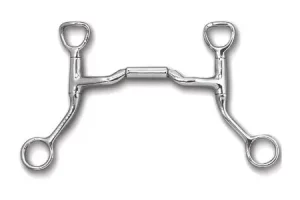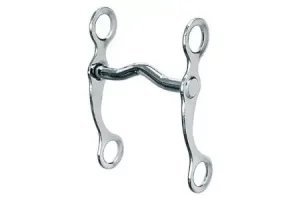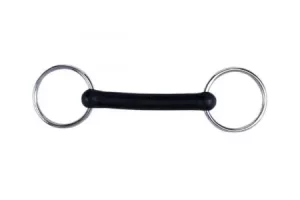If you’re looking for the best horse bit for neck reining, then you’ve come to the right place.
Neck reining is a horse training technique that can be used to cue the horse into turning or stopping. It allows you to communicate with them using very subtle signals. In order to neck rein effectively, you will need a good horse bit.
In this article, I’ll discuss five different horse bits that are perfect for neck reining. I’ll also go over some of the benefits of using a horse bit for neck reining, and how to choose the right one for your needs.
So, whether you’re a beginner or an experienced horse rider, read on to learn more about horse bits for neck reining!
Short on time? The best horse bits for neck reining are the Reinsman Little S Hackamore and the Eggbutt Snaffle Bit with Jointed Copper Mouth.
Contents
Top 5 Best Horse Bit for Neck Reining in 2025
1. Reinsman Little S Hackamore
Reinsman little S hackamore bit: Popularly known for its comfort and highly reliable experience. The best part about this horse bit is it works supernaturally. Your horse won’t suffocate after wearing the horse bit; the casing will keep him as relaxed and comfortable as without the bit.
The 965 Hackamore Stage B transition distributes weight evenly for ultimate performance. The addition of curb pressure and leverage improves the transition; perfect for neck reining.
The Arabian piece with a nose part measures around 1-inch with 7 inches of rope. The linked chain is stainless steel to withstand harsh weather and rust formation. About the noseband, that is a bit tough. Adding a piece of vet wrap would do better.
All in all, if you are looking for a high-quality and comfortable horse bit for neck reining, this is the one you should buy!
2. Eggbutt Snaffle Bit with Jointed Copper Mouth
With Eggbutt snaffle horse, let us invest and make the investment worth the outlay. The thing that compelled me to add this horse bit to the list of the best horse bit for neck reining is the stainless steel construction.
The stainless steel construction features a copper-plated mouthpiece to mark durability and reliability. The smooth texture of the mouthpiece prevents it from pinching the horse’s mouth.
Besides all, the weight of the horse bit is 0.7 pounds only. The lightweight ergonomic design doesn’t put a burden on the nose and cheeks. As you know, the style of this horse bit is English equestrian. When lined with leather English straps, the bit looks simply amazing.
3. Myler HBT Shank with Sweet Iron Mullen Barrel Low Port
Hey, are you taking your horse to the neck reining racing and want it to look attention seeking? Have Myler HBT sweet iron barrel horse bit. The moment your eyes fall on the bit, you will surely add it to your cart.
With a mild level of leverage and weight lifting, this horse bit is a worth buying option. The construction is stainless steel to last a lifetime. A patented swivel, when fitted with the nose and mouthpiece, prevents the steel case from pinching the skin.
The overall weight of the horse bit is 0.55 pounds to relax on the nose and cheeks. Amazingly, the response horses give to this horse bit is also satisfactory. On top of that, this horse bit is best for beginner’s neck reining training.
4. Weaver Leather All Purpose Ring Snaffle Bit
Are you a bit tight on budget? Have a weaver all-purpose leather snaffle horse bit. What makes me go wow over this horse bit is the quality it offers at an affordable rate.
The whole piece is coated with nickel to prevent skin allergies and rust formation. The low port mouthpiece measures around 5 inches, while the cheekpiece is around 7 inches.
The horse bit also features curb pressure and leverage. The weight distribution is even to prevent the bit from sinking into the skin. The missing ingredient I noted is the weight (4.6 pounds). Horses with sensitive nose regions might wiggle around due to the weight.
5. Korsteel Flexi Rubber Mullen Mouth Loose Ring Snaffle Bit
So you are still not satisfied with the best horse for neck reining? Look no further than the Korsteel snaffle horse bit. The reason to add this unadorned yet high-quality horse bit is because of the adjustability.
This single-piece horse bit is coated with stainless steel to prevent rust formation. The piece that lies on the nose and cheeks is adjustable and ergonomic in design.
Moreover, the fine-hand polish improves salivation. Another best part, this horse bit is idyllic to go with if you are just training your horse for neck reining. The ergonomic design will keep the horse comfortable, and perfect to learn things.
The different types of horse bits that can be used for neck reining
There are a few different types of horse bits that can be used for neck reining, each with its own set of pros and cons.
The most common types are the snaffle bit, the hackamore, and the bosal.
The snaffle bit is the most common type of horse bit used for neck reining. It is simple to use and can be very effective if used correctly. The main downside to the snaffle bit is that it can be very harsh if not used correctly, and can cause pain and discomfort to the horse.
The hackamore is another type of horse bit that can be used for neck reining. The hackamore is a bitless bridle that uses a noseband to control the horse. The hackamore is much gentler than the snaffle bit but can be more difficult to use.
The bosal is a type of horse bit that is used in conjunction with a hackamore. The bosal goes around the horse’s nose and attaches to the hackamore. The bosal helps to control the horse’s head and neck and makes it easier for the rider to neck rein.
So, which bit type is the best for neck reining? That really depends on what you are looking for in a horse bit.
If you want something that is simple to use and effective, then the snaffle bit might be right for you. If you are looking for something that is more gentle and easy to use, then the hackamore or bosal might be a better option.
It really all comes down to personal preference and what you feel comfortable using. Experiment with different types of horse bits until you find the one that works best for you and your horse.
Buyer’s Guide – How to determine the best bit for neck reining
When it comes to horse bits, there is no one-size-fits-all solution. The best bit for your horse will depend on a number of factors, including their level of training, the type of riding you do, and their individual preferences.
Here are a few things to keep in mind when choosing a horse bit for neck reining:
1. The level of training of your horse
If you are just starting out with neck reining, then you will want to choose a bit that is simple to use and not too harsh. As your horse’s training progresses, you can experiment with different types of bits to see what works best for them.
As I discussed above, different types of bits are appropriate for the neck reining; check them as well, and then decide which bit will be the best option for your horse. If you have a snaffle bit and have some knowledge snaffle bit might be a good option.
2. The type of riding you do
If you do a lot of stops and starts, then you will want a bit that is easy to use and will not cause your horse any discomfort. If you do a lot of turning, then you might want to consider a bit that is more designed for neck reining.
You can consider a loose ring snaffle with a thick double-joint mouthpiece as it is a gentler bit and effective enough to get your job done.
3. Your horse’s individual preferences
That is the basic but most important point most of us ignore. It’s good and you should ask for suggestions and advice but keep your and your horse’s preference at the top.
Every horse is different, and what works for one horse might not work for another. Pay close attention to your horse’s reactions to different bits and choose the one that they seem to be the most comfortable with.
4. Check the Bit Size
If you really want to have control of your horse then a bit with the right size is key. Make sure the bit is the right size for your horse’s mouth. If the bit is too small, it will be uncomfortable for your horse.
If the bit is too large, it will be difficult to control. So in both cases, your horse will try to escape from that condition and which will lead things from bad to worse. Make sure you have the right size and double-check when buying.
5. Consider the bit made of(material)
Having the right size is not enough. A good and comfy material is another factor considered in your decision. Some materials, such as stainless steel, are more durable and easy to clean.
Other materials, such as rubber, are more flexible and can be more comfortable for your horse. Bits with leather material or covered in leather are good options as you can control your horse as well as it will not hurt your horse.
In addition, choose a bit with a smooth surface to help prevent chafing and irritation. You want to make sure the bit you choose is not too harsh on your horse’s mouth. A smooth surface will help to prevent chafing and irritation.
Tips on how to train your horse to neck rein
Neck reining is a versatile skill that can be used for a variety of riding disciplines, from western pleasure to horse showmanship. If you’re interested in teaching your horse how to neck rein, here are a few tips to get you started:
– Start by teaching your horse the basics of direct and indirect reins. This will give them a solid foundation to work from when you start adding neck reining cues.
– Once your horse is comfortable with the basics, begin introducing neck reining cues while you are riding. Start with simple commands, such as “turn” or “stop,” and gradually increase the complexity of your cues as your horse masters them.
– Be patient and consistent with your horse while they are learning. As with any new skill, it will take time and practice for them to master neck reining.
With a little patience and some practice, you can teach your horse to neck rein like a pro!
Conclusion
Choosing the best horse bit for neck reining can be a daunting task, but it doesn’t have to be. By keeping a few key factors in mind, you can narrow down your options and find the perfect horse bit for your needs.
And with some time and practice, you can teach your horse to neck rein like a pro!
FAQ’s
What bit to use for neck reining?
The best bit for neck reining will depend on a number of factors, including your horse’s level of training, the type of riding you do, and their individual preferences. If you are just starting out, then you will want to choose a simple snaffle bit. As your horse’s training progresses, you can experiment with different types of bits to see what works best for them.
Can you neck rein with a snaffle bit?
Yes, you can neck rein with a snaffle bit. The snaffle bit is the most common type of bit used for neck reining. It is simple to use and effective. You can either choose Weaver Leather All Purpose Ring Snaffle Bit and Eggbutt Snaffle Bit with Jointed Copper Mouth. Both are good choices for neck reining.
What is a good reining bit?
There is no definitive answer to this question as every horse is different and will therefore respond differently to various types of bits. However, there are certain characteristics that many experienced riders and trainers look for in a good reining bit. These include a bit that is relatively slim in width, has a moderate to high port, and is made of a smooth, non-abrasive material such as stainless steel.
These are five good reining bits you can consider;
- Reinsman Little S Hackamore
- Eggbutt Snaffle Bit with Jointed Copper Mouth
- Myler HBT Shank with Sweet Iron Mullen Barrel Low Port
- Weaver Leather All Purpose Ring Snaffle Bit
- Korsteel Flexi Rubber Mullen Mouth Loose Ring Snaffle Bit
What is the difference between neck reining and direct reining?
The main difference between neck reining and direct reining is the amount of contact the rider has with the horse’s mouth. When neck reining, the rider only has contact with the horse’s neck, while when direct reining, the rider has direct contact with the horse’s mouth.
Neck reining is often considered to be a more gentle way of steering a horse, as there is less contact with the horse’s sensitive mouth area. It can also be helpful in situations where the rider needs to keep one hand free, such as when carrying a flag or opening a gate.
However, neck reining can also be more difficult to master than direct reining, and it is important to make sure that the horse is properly trained before attempting to neck rein.




